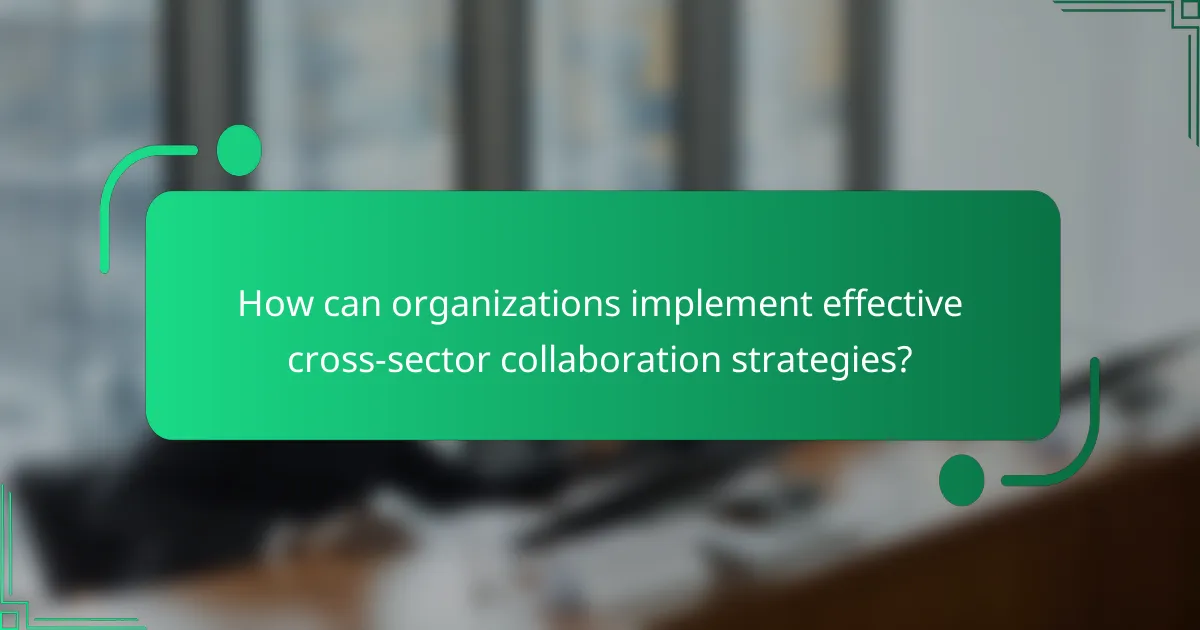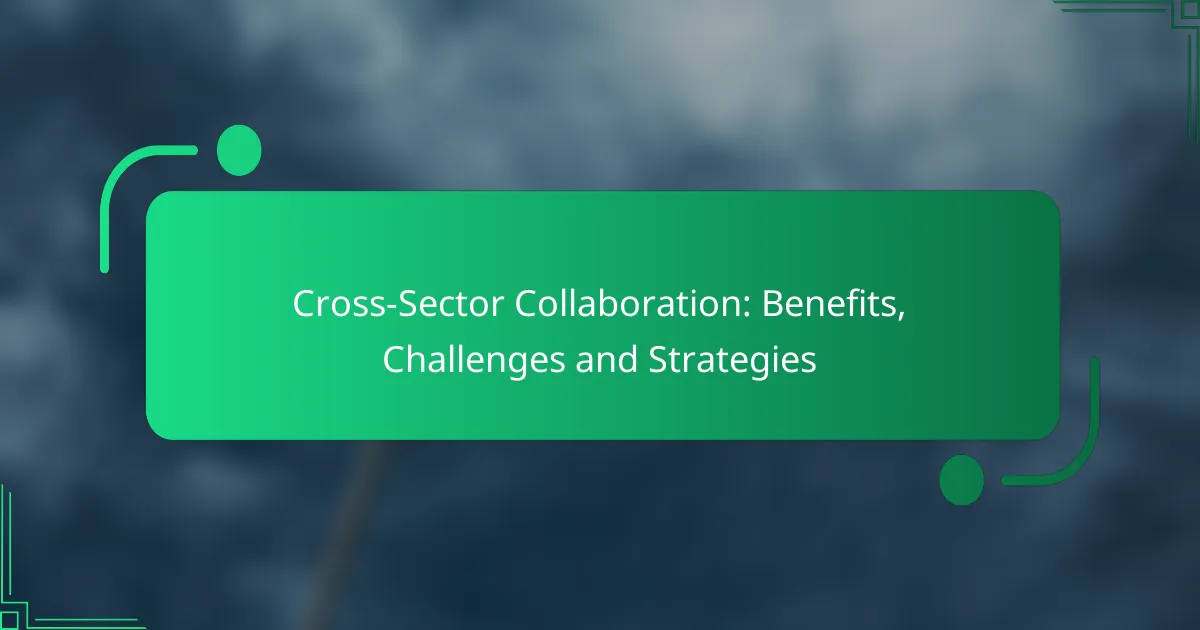Cross-sector collaboration unites diverse organizations to tackle shared challenges, fostering innovation and resource sharing for greater efficiency. While this approach offers significant benefits, it also presents challenges such as communication barriers and differing organizational cultures. By implementing strategic measures like clear objective setting and trust-building, stakeholders can enhance their collaborative efforts and achieve impactful outcomes.

What are the benefits of cross-sector collaboration?
Cross-sector collaboration brings together diverse organizations to achieve common goals, resulting in numerous advantages such as enhanced innovation, resource sharing, and increased efficiency. By leveraging the strengths of different sectors, stakeholders can create more impactful solutions to complex challenges.
Enhanced innovation
Cross-sector collaboration fosters enhanced innovation by combining unique perspectives and expertise from various fields. This diversity often leads to creative problem-solving and the development of novel ideas that may not emerge within a single sector.
For instance, partnerships between technology firms and healthcare providers have led to groundbreaking advancements in telemedicine and health monitoring devices. Such collaborations can significantly accelerate the pace of innovation.
Resource sharing
Resource sharing is a key benefit of cross-sector collaboration, allowing organizations to pool financial, human, and technological resources. This can lead to cost savings and optimized use of assets, which is particularly beneficial for non-profits and startups with limited budgets.
For example, a local government might partner with a private company to share infrastructure resources, reducing expenses while improving service delivery to the community.
Increased efficiency
Increased efficiency is often a direct outcome of cross-sector collaboration, as organizations can streamline processes and eliminate redundancies. By working together, partners can identify best practices and implement them across sectors.
A practical example is a collaboration between educational institutions and businesses that aligns curricula with industry needs, ensuring that graduates are better prepared for the workforce, thus reducing training costs for employers.
Broader impact
Cross-sector collaboration can lead to broader impact by addressing complex social issues that require a multifaceted approach. When different sectors unite, they can tackle challenges such as poverty, health disparities, and environmental sustainability more effectively.
For instance, a partnership involving government agencies, NGOs, and private companies can create comprehensive programs that address food security, benefiting a larger segment of the population than any single entity could achieve alone.
Improved stakeholder engagement
Improved stakeholder engagement is another significant benefit of cross-sector collaboration, as it encourages active participation from various groups. Engaging diverse stakeholders helps build trust and fosters a sense of ownership over initiatives.
For example, involving community members in planning processes can lead to more relevant solutions and higher levels of support for projects, ultimately enhancing their success and sustainability.

What challenges arise in cross-sector collaboration?
Cross-sector collaboration often faces several challenges that can hinder its effectiveness. Key issues include communication barriers, differing organizational cultures, conflicts over resource allocation, and difficulties in measuring success.
Communication barriers
Effective communication is crucial in cross-sector collaboration, yet it can be significantly hampered by jargon, differing terminologies, and varying communication styles. Misunderstandings can arise when stakeholders from different sectors interpret messages differently, leading to confusion and frustration.
To mitigate communication barriers, establish clear channels and protocols for information sharing. Regular meetings and updates can help ensure all parties are aligned and informed, reducing the risk of miscommunication.
Differing organizational cultures
Each organization involved in cross-sector collaboration typically has its own culture, which can lead to clashes in values, priorities, and working styles. These cultural differences can create friction and impede collaboration if not addressed properly.
To navigate these cultural differences, it is essential to foster mutual respect and understanding among partners. Engaging in team-building activities and workshops can help bridge cultural gaps and promote a shared vision for the collaboration.
Resource allocation conflicts
Resource allocation is often a contentious issue in cross-sector collaboration, as organizations may have competing interests regarding funding, personnel, and time. Disagreements over how resources are distributed can lead to tensions and hinder project progress.
To minimize conflicts, establish clear agreements on resource allocation at the outset of the collaboration. Regularly revisiting these agreements can help ensure that all parties feel their contributions are valued and that resources are being used effectively.
Measurement of success
Measuring success in cross-sector collaboration can be challenging due to differing objectives and metrics among partners. Without a common understanding of what success looks like, it can be difficult to assess the effectiveness of the collaboration.
To address this issue, develop shared success criteria early in the collaboration process. Utilize both qualitative and quantitative metrics to evaluate progress, ensuring all stakeholders agree on what constitutes success and how it will be measured.

How can organizations implement effective cross-sector collaboration strategies?
Organizations can implement effective cross-sector collaboration strategies by clearly defining their objectives, building trust among partners, leveraging technology for communication, and engaging stakeholders early in the process. These steps ensure that all parties are aligned and can work together efficiently towards common goals.
Establish clear goals
Setting clear goals is essential for successful cross-sector collaboration. Organizations should identify specific, measurable outcomes that they aim to achieve together. This clarity helps all partners understand their roles and responsibilities, reducing confusion and enhancing accountability.
For example, if a public health organization collaborates with a private tech firm, their goal might be to develop a health monitoring app within six months. This specific target provides a timeline and a clear focus for the collaboration.
Foster trust among partners
Trust is a foundational element of effective collaboration. Organizations should prioritize building relationships through open communication, transparency, and shared values. Regular meetings and informal interactions can help strengthen these bonds.
One practical approach is to establish a joint governance structure where all partners have a say in decision-making. This inclusivity fosters a sense of ownership and commitment among all parties involved.
Utilize technology for communication
Leveraging technology can significantly enhance communication in cross-sector collaborations. Tools such as project management software, video conferencing, and collaborative platforms enable real-time updates and facilitate discussions, regardless of geographical barriers.
For instance, using platforms like Slack or Microsoft Teams can streamline communication, allowing teams to share documents and updates instantly. This reduces delays and keeps everyone informed and engaged.
Engage stakeholders early
Engaging stakeholders early in the collaboration process is crucial for aligning interests and expectations. Involving them from the outset ensures that their insights and concerns are considered, which can lead to more effective solutions.
Organizations can conduct workshops or focus groups to gather input from stakeholders. This proactive approach not only enhances buy-in but also helps identify potential challenges before they escalate, leading to smoother collaboration.

What frameworks support cross-sector collaboration?
Several frameworks facilitate cross-sector collaboration by providing structured approaches for different stakeholders to work together effectively. These frameworks help align goals, resources, and strategies across various sectors, enhancing the potential for successful partnerships.
Collaborative governance models
Collaborative governance models involve shared decision-making processes among stakeholders from different sectors, including government, private, and non-profit organizations. These models emphasize transparency, inclusiveness, and accountability, ensuring that all voices are heard and considered.
Key steps in implementing collaborative governance include establishing clear objectives, defining roles and responsibilities, and creating mechanisms for communication and feedback. Examples include multi-stakeholder forums and advisory committees that bring together diverse perspectives to tackle complex issues.
Common pitfalls to avoid include unclear governance structures and lack of commitment from key players. Regular assessments and adjustments to the governance model can help maintain engagement and effectiveness.
Public-private partnership frameworks
Public-private partnership (PPP) frameworks are collaborative agreements between government entities and private sector organizations aimed at delivering public services or infrastructure projects. These partnerships leverage the strengths of both sectors, such as public oversight and private efficiency.
Successful PPPs typically involve clear contractual agreements that outline the roles, risks, and rewards for each party. Examples include infrastructure projects like toll roads or public transportation systems, where private firms finance and operate services under government regulation.
When considering PPPs, it is crucial to assess the financial implications and ensure that public interests are safeguarded. Establishing performance metrics and regular monitoring can help ensure that the partnership meets its objectives and delivers value to the community.

What are some successful examples of cross-sector collaboration?
Successful cross-sector collaboration often involves partnerships between government, businesses, and non-profits to address complex societal challenges. These collaborations can lead to innovative solutions and shared resources, enhancing the impact of initiatives.
UN Sustainable Development Goals initiatives
The UN Sustainable Development Goals (SDGs) provide a framework for cross-sector collaboration aimed at addressing global challenges such as poverty, inequality, and climate change. Various stakeholders, including governments, private companies, and civil society organizations, work together to achieve these goals by sharing expertise, resources, and networks.
One notable example is the partnership between the UN and the private sector to promote sustainable business practices. Companies are encouraged to align their operations with the SDGs, which can lead to improved sustainability and social responsibility while also enhancing their brand reputation.
To effectively engage in SDG initiatives, organizations should identify specific goals that align with their mission and capabilities. Collaborating with diverse partners can amplify efforts and create a more significant impact. Regularly measuring progress and adapting strategies is crucial for success in these initiatives.
